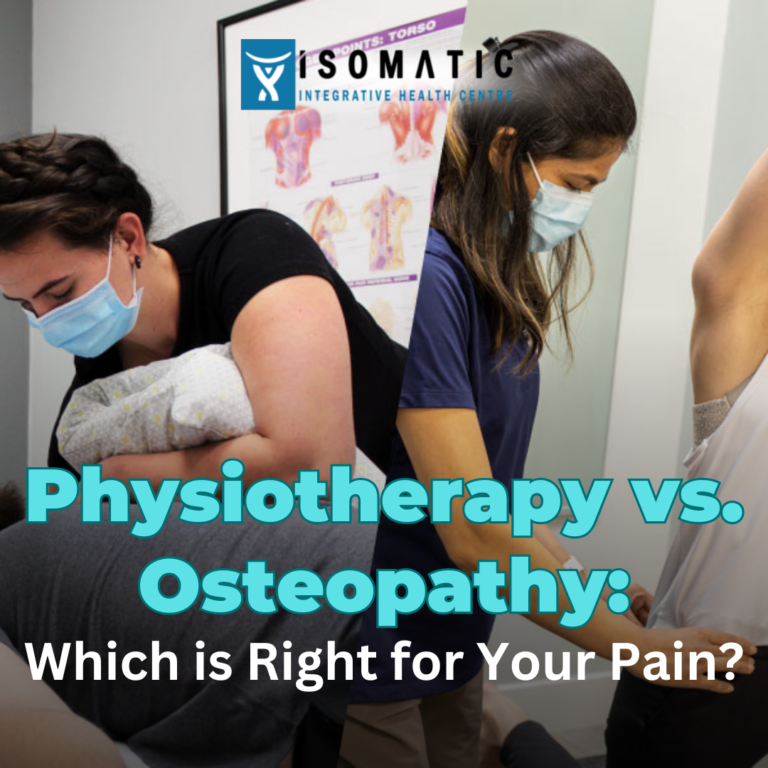
Can Physiotherapy Improve Your Immune System?
Can Physiotherapy Improve Your Immune System? Most people think of physiotherapy as treatment for injuries, pain, or movement limitations—but its benefits extend far beyond rehabilitation.

When dealing with persistent pain, injuries, or mobility issues, choosing the right treatment is crucial. Physiotherapy and osteopathy are two common approaches that aim to relieve pain, restore movement, and enhance overall well-being. However, they differ significantly in techniques, philosophy, and treatment approaches.
This guide will provide a detailed comparison of physiotherapy vs. osteopathy, helping you determine which one is best suited for your specific condition. Whether you’re recovering from an injury, managing chronic pain, or simply looking to improve mobility, understanding these two therapies will empower you to make the right choice.
Physiotherapy is a science-based healthcare profession that focuses on improving movement, function, and quality of life through physical methods such as exercise, manual therapy, electrotherapy, and education.
Key principles of physiotherapy:
Who benefits from physiotherapy? Physiotherapy is highly beneficial for individuals suffering from:
Osteopathy is a holistic, hands-on therapy that emphasizes the body’s self-healing ability. It primarily focuses on manual therapy techniques to address structural and functional imbalances.
Core principles of osteopathy:
Who benefits from osteopathy? Osteopathy is ideal for individuals dealing with:
| Feature | Physiotherapy | Osteopathy |
|---|---|---|
| Philosophy | Evidence-based, movement-focused therapy | Holistic, hands-on approach to healing |
| Treatment Focus | Muscles, joints, and movement patterns | Entire body, including internal systems |
| Techniques Used | Exercise, electrotherapy, manual therapy | Hands-on techniques like massage, joint manipulation |
| Best For | Post-surgical recovery, sports injuries, neurological conditions | Chronic pain, postural imbalances, stress-related pain |
| Regulation & Training | Requires a degree in physiotherapy and certification | Requires a degree in osteopathy with clinical training |
| Session Structure | Focuses on physical rehabilitation through structured exercise plans | Focuses on manual therapy to improve overall function |
If you have undergone surgery, suffered a sports injury, or need structured rehabilitation, physiotherapy is the better choice. It provides scientifically backed exercises and techniques to restore function and strength.
For individuals with persistent back pain, migraines, or postural issues, osteopathy may be more beneficial. It targets not only the muscles and joints but also considers the body’s natural ability to heal.
If you prefer manual therapy that involves soft tissue manipulation, joint mobilization, and holistic healing, osteopathy is more suitable. Physiotherapy, on the other hand, relies more on exercise and rehabilitation techniques.
Patients with conditions like stroke, multiple sclerosis, or Parkinson’s disease benefit greatly from physiotherapy, as it includes specialized techniques for improving motor function and coordination.
Both therapies can be used for prevention, but physiotherapy excels in injury prevention, particularly for athletes and active individuals. Osteopathy, however, is excellent for maintaining general body balance and well-being.
Seek physiotherapy if you: ✅ Have a sports injury or post-surgical pain
✅ Experience mobility limitations
✅ Need rehabilitation after an accident
✅ Have a neurological disorder affecting movement
✅ Want a structured exercise plan for strength and flexibility
Consult an osteopath if you:
✅ Have persistent back, neck, or joint pain
✅ Suffer from headaches or migraines due to muscle tension
✅ Experience digestive issues linked to musculoskeletal problems
✅ Prefer hands-on therapy for overall body alignment
✅ Need relief from chronic stress-related pain
Yes! Many individuals benefit from a combination of both therapies.
For example, if you’re recovering from a knee injury, a physiotherapist can guide you through strength exercises, while an osteopath can help with joint alignment and reducing tension.
🚫 “Osteopathy is just massage therapy.”
✅ Osteopathy involves joint manipulation, muscle work, and even cranial therapy, not just massage.
🚫 “Physiotherapy only works for athletes.”
✅ Physiotherapy benefits people of all ages, from children to seniors, helping with various health conditions.
🚫 “Osteopathy is not evidence-based.”
✅ While osteopathy takes a holistic approach, many techniques are supported by scientific research.
🚫 “You must choose one or the other.”
✅ Both therapies can complement each other for better pain relief and recovery.
Is physiotherapy better than osteopathy?
Neither is “better”—it depends on your specific condition. Physiotherapy is exercise-based, while osteopathy is manual therapy-focused.
How many sessions do I need?
This varies by individual. Some people see improvement after 2-3 sessions, while chronic conditions may require ongoing treatment.
Is osteopathy covered by insurance?
Many health insurance plans cover both therapies, but coverage depends on your provider and country.
Can osteopathy help with stress and anxiety?
Yes! Osteopathy

Can Physiotherapy Improve Your Immune System? Most people think of physiotherapy as treatment for injuries, pain, or movement limitations—but its benefits extend far beyond rehabilitation.

Headaches and Tension? Try These Hands-On Osteopathic Solutions Headaches caused by tension can be draining, distracting, and downright frustrating. Whether they come from long hours

Isometric Exercises: Why We Recommend Them in Recovery When you’re healing from an injury, not all exercises are safe—some movements can even set you back.